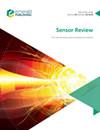用于快速气体识别的快速低成本多用途电子鼻的设计与验证
IF 1.4
4区 工程技术
Q3 INSTRUMENTS & INSTRUMENTATION
引用次数: 0
摘要
目的本文的目的是使用商用金属氧化物气体传感器(MOX)设计和验证电子鼻(E-nose)原型。该原型有一个传感器阵列板,集成了八个不同的MOX气体传感器,以处理多用途应用。传感器的数量可以适应不同的要求和分类情况。本文介绍了该电子鼻原型在用于识别酒精、丁烷和香烟烟雾三种气体样本时的验证。同时,讨论了原型对酒精、丙酮及其混合物的鉴别能力。在这方面,选择适当类型和数量的气体传感器,以及以小型化设计和最小计算时间获得优异的判别能力,都是这种实现的驱动因素。设计/方法论/方法建议的原型包括两个主要部分:硬件(低成本组件)和软件(机器学习)。互连印刷电路板、树莓派和带有传感器阵列板的传感器室构成第一部分。对八个传感器进行了测试,以了解它们对手头的分类任务的有效性和可行性,然后选择了最低限度的传感器。第二部分由机器学习算法组成,旨在确保数据采集和处理。这些算法包括特征提取、降维和分类。为了执行分类任务,使用了传感器瞬态响应的两个特征。结果表明,该系统具有较高的识别能力。K-最近邻(KNN)和基于支持向量机径向基函数(SVM-RBF)的分类器的平均准确率分别为97.81%和98.44%。这些结果是在使用线性判别分析进行数据降维后获得的,线性判别分析在判别力方面比主成分分析更有效。使用重复分层K-交叉验证来训练和测试五种不同的机器学习分类器。每个分类器都在数据集上进行了测试,以确定其准确性。SVM-RBF模型在多次重复和不同的数据分割中具有高、稳定和一致的精度。检测和识别的总执行时间约为10 s.Originality/value使用从传感器瞬态响应中提取的信息,该系统被证明能够准确地对八个MQ-X气体传感器中的三个传感器的气体类型进行分类。SVM-RBF分类器的训练和验证结果显示出良好的偏差-方差权衡。这证明了这两个瞬态特征对于该分类目的是足够有效的。此外,所有数据处理任务都由Raspberry Pi执行,它以小型化的架构和低廉的价格显示了实时数据处理。本文章由计算机程序翻译,如有差异,请以英文原文为准。
The design and validation of a fast and low-cost multi-purpose electronic nose for rapid gas identification
Purpose
The purpose of this paper is to design and validate an electronic nose (E-nose) prototype using commercially available metal oxide gas sensors (MOX). This prototype has a sensor array board that integrates eight different MOX gas sensors to handle multi-purpose applications. The number of sensors can be adapted to match different requirements and classification cases. The paper presents the validation of this E-nose prototype when used to identify three gas samples, namely, alcohol, butane and cigarette smoke. At the same time, it discusses the discriminative abilities of the prototype for the identification of alcohol, acetone and a mixture of them. In this respect, the selection of the appropriate type and number of gas sensors, as well as obtaining excellent discriminative abilities with a miniaturized design and minimal computation time, are all drivers for such implementation.
Design/methodology/approach
The suggested prototype contains two main parts: hardware (low-cost components) and software (Machine Learning). An interconnection printed circuit board, a Raspberry Pi and a sensor chamber with the sensor array board make up the first part. Eight sensors were put to the test to see how effective and feasible they were for the classification task at hand, and then the bare minimum of sensors was chosen. The second part consists of machine learning algorithms designed to ensure data acquisition and processing. These algorithms include feature extraction, dimensionality reduction and classification. To perform the classification task, two features taken from the sensors’ transient response were used.
Findings
Results reveal that the system presents high discriminative ability. The K-nearest neighbor (KNN) and support vector machine radial basis function based (SVM-RBF) classifiers both achieved 97.81% and 98.44% mean accuracy, respectively. These results were obtained after data dimensionality reduction using linear discriminant analysis, which is more effective in terms of discrimination power than principal component analysis. A repeated stratified K-cross validation was used to train and test five different machine learning classifiers. The classifiers were each tested on sets of data to determine their accuracy. The SVM-RBF model had high, stable and consistent accuracy over many repeats and different data splits. The total execution time for detection and identification is about 10 s.
Originality/value
Using information extracted from transient response of the sensors, the system proved to be able to accurately classify the gas types only in three out of the eight MQ-X gas sensors. The training and validation results of the SVM-RBF classifier show a good bias-variance trade-off. This proves that the two transient features are sufficiently efficient for this classification purpose. Moreover, all data processing tasks are performed by the Raspberry Pi, which shows real-time data processing with miniaturized architecture and low prices.
求助全文
通过发布文献求助,成功后即可免费获取论文全文。
去求助
来源期刊

Sensor Review
工程技术-仪器仪表
CiteScore
3.40
自引率
6.20%
发文量
50
审稿时长
3.7 months
期刊介绍:
Sensor Review publishes peer reviewed state-of-the-art articles and specially commissioned technology reviews. Each issue of this multidisciplinary journal includes high quality original content covering all aspects of sensors and their applications, and reflecting the most interesting and strategically important research and development activities from around the world. Because of this, readers can stay at the very forefront of high technology sensor developments.
Emphasis is placed on detailed independent regular and review articles identifying the full range of sensors currently available for specific applications, as well as highlighting those areas of technology showing great potential for the future. The journal encourages authors to consider the practical and social implications of their articles.
All articles undergo a rigorous double-blind peer review process which involves an initial assessment of suitability of an article for the journal followed by sending it to, at least two reviewers in the field if deemed suitable.
Sensor Review’s coverage includes, but is not restricted to:
Mechanical sensors – position, displacement, proximity, velocity, acceleration, vibration, force, torque, pressure, and flow sensors
Electric and magnetic sensors – resistance, inductive, capacitive, piezoelectric, eddy-current, electromagnetic, photoelectric, and thermoelectric sensors
Temperature sensors, infrared sensors, humidity sensors
Optical, electro-optical and fibre-optic sensors and systems, photonic sensors
Biosensors, wearable and implantable sensors and systems, immunosensors
Gas and chemical sensors and systems, polymer sensors
Acoustic and ultrasonic sensors
Haptic sensors and devices
Smart and intelligent sensors and systems
Nanosensors, NEMS, MEMS, and BioMEMS
Quantum sensors
Sensor systems: sensor data fusion, signals, processing and interfacing, signal conditioning.
 求助内容:
求助内容: 应助结果提醒方式:
应助结果提醒方式:


